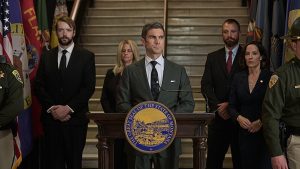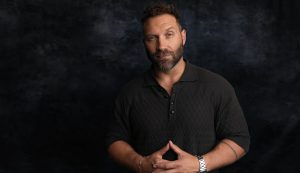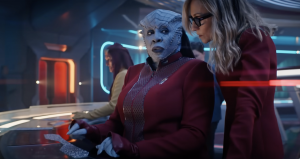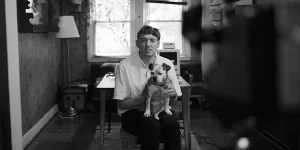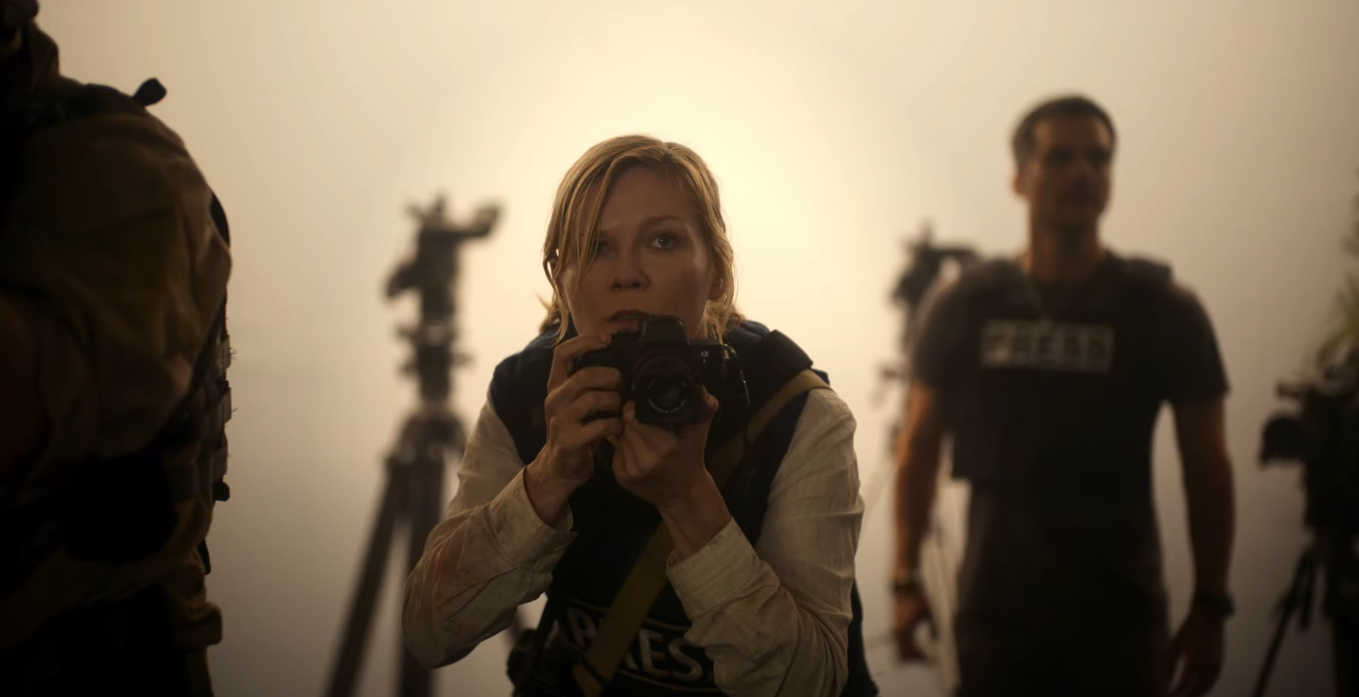
Despite sharing a vehicle with three veteran journalists, young aspiring war photographer Jessie (Cailee Spaeny) cannot help but break down into tears. The quartet just drove away from a gas station held by attendants who may, or may not, be combatants in a conflict that’s gripped the entire United States. They’re certainly armed when they show Jessie and her more experienced hero Lee (Kirsten Dunst) three looters they captured and have been beating for days. In that moment, the gunman also gave Jessie a choice, offering to either kill the looters now or let them go after a few more days of torture.
When Jessie failed to respond, Lee took action… of a sort. She took a photo of the man with the gun and his prisoners, substituting watching for action. As Jessie cries, Lee justifies her non-action. “Once you start asking yourself those questions, you can’t stop,” she barks at her fragile fan. “So we don’t ask. We record, so other people ask.”
For some viewers of Civil War, any frustration at Lee could also be directed at the film itself. Written and directed by Alex Garland, Civil War depicts a future America in which secessionists in Florida and Texas take up arms against their fellow citizens. Yet despite releasing Civil War into an actual America given to bitter and sometimes violent disagreement, Garland resolutely avoids clear signifiers to our present political moment. As much as we viewers might identify with Jessie, weeping in impotent shame, the film asks us to take seriously Lee’s argument and understand the distinction between watching and doing… and not to mistake one for the other.
Present Politics
When Den of Geek asked Garland last spring about the lack of clear political context in Civil War, he responded in ironically unmistakable terms. “It’s just complete bullshit,” Garland declared. He insisted that the film does in fact make a political statement, even if it isn’t necessarily the one the viewer wants. “To me, [that charge] involves implicitly a degree of contempt, a sort of built in degree of contempt for other people.”
Indeed, Garland said the movie is about fascism, which he sees as potentially imminent in the U.S. and elsewhere. However, he also insists that Civil War “is essentially substantially about journalists … and it’s about if you erode a system of checks and balances, which includes the fourth estate, it puts you on a road to fascism.”
That’s big talk for a movie in which the president (Nick Offerman) sometimes uses Trump-esque language and boastfulness (“Some are already calling it the greatest victory in the history of mankind”), but never becomes a direct satire or attack on the former POTUS, like, say, Alec Baldwin‘s take on Saturday Night Live. It’s also big talk for a movie that features citizens, dressed in Tommy Bahama shirts and blue jeans, engaging in military maneuvers against other citizens.
Civil War seems like it’s on the verge of being specific about the current state of America, but then turns instead toward messy signifiers. Yet, by pointing back to the fourth estate, Garland’s comments underscore a question of responsibility at work in Civil War.
Watching the Watchers
While making their way to Washington, the wartorn landscape breaks, revealing perfect suburbs and clean city streets. Inside a clothing store, writer Joel (Wagner Moura) incredulously asks the shopgirl if she knows about the war.
“Oh, sure, but” the clerk responds, shrugging her shoulders, “we just try to stay out.” Despite his obvious disgust, Joel takes time to enjoy himself in the shop, trying on clothes and being silly, as do Lee and Jessie. They seem happy, human. Even Lee breaks her steely facade to allow for a pleasant smile, captured on film by Jessie. But when Lee goes back outside the store to check on her older colleague Sammy (Stephen McKinley Henderson), things change. A master shot shows Sammy leaning against the car and Lee relaxed, almost tranquil.
“It’s so weird,” Lee admits. “This place is like everything I’d forgotten.” Sammy smiles in a close-up. “Funny. I was thinking it felt like everything I remembered.”
The camera returns to the master shot to watch as confusion undercuts Lee’s tranquility. Sammy keeps his own cool as he hands Lee a cigarette and instructs her to subtly look at the building tops. The camera pans just slightly up and shifts focus, revealing two snipers atop the building, watching them.
The quiet reveal of the gunmen, done so subtly that it almost goes without notice, illustrates a truth running both within and without Civil War. No matter what the shopgirl thinks, the townspeople are not staying out. They are very much in it, because mere proximity to and awareness of the fighting draws them to react and make choice whether they want to be part of it or not. The town’s decision to ignore the rest of the fighting is itself an action, one they underwrite with bullets and guns.
The same is true of the journalists in Civil War. They make the decision to watch, and by watching force others to stare into the abyss as well. Garland underscores this idea with several moments of watchers observing others throughout the film. The first occurs at the start of the movie, right after a suicide bomber kills himself in a crowd. The sound dropped from the soundtrack represents Jessie’s loss of hearing as we see her stumble through a the crowd in a daze. But when Jessie sees Lee, unaffected by the explosion and wading into the bodies to take pictures, the camera takes Jessie’s perspective and, eventually, her camera.
She watches Lee. We watch Lee. We watch Jessie watching Lee.
Right Watching
According to an apocryphal tale about the actual American Civil War, Abraham Lincoln described author Harriet Beecher Stowe as “the little lady that started this big war.” The comment not only overstates Stowe’s influence, but also flies in the face of Stowe’s own thoughts about the effect of her novel Uncle Tom’s Cabin.
In the “Concluding Remarks” section of Uncle Tom’s Cabin, Stowe rhetorically asks and answers this question: “But, what can any individual do? Of that, every individual can judge. There is one thing that every individual can do,—they can see to it that they feel right. An atmosphere of sympathetic influence encircles every human being; and the man or woman who feels strongly, healthily and justly, on the great interests of humanity, is a constant benefactor to the human race. See, then, to your sympathies in this matter!”
A modern version of “right feeling” might be “right-watching.” In the same way that Stowe conflates feelings with actions (a predecessor to our too common “thoughts and prayers” refrain), modern viewers want to believe that if we support art that depicts our worldviews, then we have somehow brought those ideas into the real world.
In that version of Civil War, Offerman’s president wouldn’t just indulge in occasional vague hyperbole or shiver in cowardice when actual guns are pointed at him. Rather he would overtly echo Trump, complete with dogwhistles and mocking impressions. In that version of Civil War, Florida would align with Texas or Alabama instead of California, and the resistance soldiers would sport Punisher logos and Don’t Tread on Me flags. In that version, we could leave the theater confident that we’re all in agreement about our morals and can walk right past racist bumper stickers on cars in the parking lot, insisting that our eyes are still adjusting to the sunlight.
The Civil War we got doesn’t let us off so easily. It knows the frustration we feel at Lee’s “we don’t ask” evasion. But it also knows that we viewers do things the same way. We viewers don’t ask the hard questions either. Instead we watch other movies with more pointed imagery and feel good about ourselves for our right, correct watching, confident that the actual activists we see on the screen do enough work for everyone. Civil War doesn’t trust that we’ll convert that right feeling into right doing, that we’ll actually emulate Lee by discarding evasion for action when she sacrifices herself to shield Jessie at the end of the film. Instead it asks us, like Jessie, to watch her die through the point-of-view of a lens.
From Watching to Doing
Lee’s death occurs at Civil War‘s climax, when the journalists finally make it to the White House and trail behind resistance soldiers through the halls and into the Oval Office. Garland depicts her death not directly, but via the photographs that Jessie shoots from the ground. One black and white image captures Lee looking down at Jessie’s camera. Another finds her making a strange expression. And in the rest that follow, she collapses to the ground.
Even here, Civil War doesn’t tell the viewer how to feel. Lee’s sacrifice undermines her constant insistence that she won’t take care of Jessie and provides an ironic echo to a conversation about shooting pictures of dead friends. Indeed, Jessie takes the picture of her hero and mentor and then moves on with her work, with us viewers following along. We don’t feel right about what we see, and that’s the point. Right feeling, right watching, is never enough to combat the fascism that Garland knows is very real. It’s only right doing.
Like Lee, Civil War records so that other people ask. Or, maybe more accurately, it records so that other people act. And it’s up to us to follow Lee’s lead and do something about it.
Civil War is now streaming on Max.
The post Civil War Indicts Its Activist Watchers appeared first on Den of Geek.

